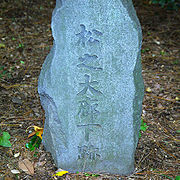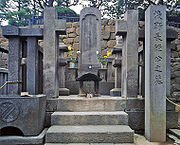
Asano Naganori
Encyclopedia

was the daimyo
Daimyo
is a generic term referring to the powerful territorial lords in pre-modern Japan who ruled most of the country from their vast, hereditary land holdings...
of the Akō Domain
Ako Domain
The was a domain in feudal Japan. It was located in Harima Province and coincided with the present-day cities of Akō and Aioi and the town of Kamigōri in Hyōgo Prefecture. The domain had its headquarters at Akō Castle....
in Japan
Japan
Japan is an island nation in East Asia. Located in the Pacific Ocean, it lies to the east of the Sea of Japan, China, North Korea, South Korea and Russia, stretching from the Sea of Okhotsk in the north to the East China Sea and Taiwan in the south...
(1675 - 1701). His title was Takumi no Kami (内匠頭). He is known as the person who triggered a series of incidents retold in a story known as Chushingura
Chushingura
is the name for fictionalized accounts of the historical revenge by the Forty-seven Ronin of the death of their master, Asano Naganori. Including the early , the story has been told in kabuki, bunraku, stage plays, films, novels, television shows and other media...
, one of the favourite themes of kabuki
Kabuki
is classical Japanese dance-drama. Kabuki theatre is known for the stylization of its drama and for the elaborate make-up worn by some of its performers.The individual kanji characters, from left to right, mean sing , dance , and skill...
, joruri
Bunraku
, also known as Ningyō jōruri , is a form of traditional Japanese puppet theater, founded in Osaka in 1684.Three kinds of performers take part in a bunraku performance:* Ningyōtsukai or Ningyōzukai—puppeteers* Tayū—the chanters* Shamisen players...
and Japanese books and films.
He was born in Edo
Edo
, also romanized as Yedo or Yeddo, is the former name of the Japanese capital Tokyo, and was the seat of power for the Tokugawa shogunate which ruled Japan from 1603 to 1868...
as the eldest son of Asano Nagatomo
Asano Nagatomo
was a Japanese daimyo of the Edo period, who ruled the Akō Domain. He was the father of the famous Asano Naganori.-References:*This article is derived from corresponding content on the Japanese Wikipedia....
. His family was a branch of the Asano family
Asano family
The ' was a noble samurai family in feudal Japan which controlled the han of Hiroshima centered around Hiroshima Castle for much of the Edo period....
whose main lineage was in Hiroshima
Hiroshima
is the capital of Hiroshima Prefecture, and the largest city in the Chūgoku region of western Honshu, the largest island of Japan. It became best known as the first city in history to be destroyed by a nuclear weapon when the United States Army Air Forces dropped an atomic bomb on it at 8:15 A.M...
. His grandfather Naganao was appointed to the position of daimyo of Ako with 50 thousand koku
Koku
The is a Japanese unit of volume, equal to ten cubic shaku. In this definition, 3.5937 koku equal one cubic metre, i.e. 1 koku is approximately 278.3 litres. The koku was originally defined as a quantity of rice, historically defined as enough rice to feed one person for one year...
. After Naganao died in 1671, Nagatomo succeeded to the position but died after three years in 1675. Naganori succeeded to his father at the age of nine.
In 1680, he was appointed to the office of Takumi no Kami, the head of carpentry at the imperial court, but this office was nominal, as were other offices granted to samurai at that time, and only had an honorific meaning. As a daimyo with a small fief, he was appointed several times to temporary minor offices of the Tokugawa shogunate
Tokugawa shogunate
The Tokugawa shogunate, also known as the and the , was a feudal regime of Japan established by Tokugawa Ieyasu and ruled by the shoguns of the Tokugawa family. This period is known as the Edo period and gets its name from the capital city, Edo, which is now called Tokyo, after the name was...
. In 1683, he was first appointed to be one of two officials to host the emissaries from the imperial court to the Shogunate. It was the first time he met Kira Yoshinaka
Kira Yoshinaka
was a kōke . His court title was Kōzuke no suke. He is famous as the adversary of Asano Naganori in the events of the Forty-seven Ronin...
, the highest-ranking koke
Koke
A was a noble ranking below a daimyo in Japan during the Edo period. Their lands were assessed at less than ten thousand koku, making them ineligible for the rank of daimyo.Unlike hatamoto, whose duties were military, the kōke had certain privileged missions...
, the head of ceremonial matters at the Shogunate, who instructed officials in the manner of hosting noble guests from Kyoto.
In 1694, he suffered from a serious illness. He had no children, thus no heir at that time. When a daimyo died without a determined heir, his house would be abolished by the Shogunate, and his lands confiscated; his retainers would become ronin
Ronin
A or rounin was a Bushi with no lord or master during the feudal period of Japan. A samurai became masterless from the death or fall of his master, or after the loss of his master's favor or privilege....
. To prevent this, he adopted his younger brother Asano Nagahiro, titled Daigaku, and Nagahiro was accepted as his heir by the Shogunate.
In 1701, he was appointed for the second time to the same office. It is said that he was then on bad terms with Kira Yoshinaka
Kira Yoshinaka
was a kōke . His court title was Kōzuke no suke. He is famous as the adversary of Asano Naganori in the events of the Forty-seven Ronin...
and tension between them increased.

Edo Castle
, also known as , is a flatland castle that was built in 1457 by Ōta Dōkan. It is located in Chiyoda in Tokyo, then known as Edo, Toshima District, Musashi Province. Tokugawa Ieyasu established the Tokugawa shogunate here. It was the residence of the shogun and location of the shogunate, and also...
in what is now Tokyo
Tokyo
, ; officially , is one of the 47 prefectures of Japan. Tokyo is the capital of Japan, the center of the Greater Tokyo Area, and the largest metropolitan area of Japan. It is the seat of the Japanese government and the Imperial Palace, and the home of the Japanese Imperial Family...
. He wounded, but failed to kill Kira. On the same day, the fifth Tokugawa
Tokugawa shogunate
The Tokugawa shogunate, also known as the and the , was a feudal regime of Japan established by Tokugawa Ieyasu and ruled by the shoguns of the Tokugawa family. This period is known as the Edo period and gets its name from the capital city, Edo, which is now called Tokyo, after the name was...
shogun Tsunayoshi
Tokugawa Tsunayoshi
was the fifth shogun of the Tokugawa dynasty of Japan. He was the younger brother of Tokugawa Ietsuna, thus making him the son of Tokugawa Iemitsu, the grandson of Tokugawa Hidetada, and the great-grandson of Tokugawa Ieyasu....
sentenced him to commit seppuku
Seppuku
is a form of Japanese ritual suicide by disembowelment. Seppuku was originally reserved only for samurai. Part of the samurai bushido honor code, seppuku was either used voluntarily by samurai to die with honor rather than fall into the hands of their enemies , or as a form of capital punishment...
, which he did after writing his death poem
Death poem
A death poem is a poem written near the time of one's own death. It is a tradition for literate people to write one in a number of different cultures, especially in Joseon Korea and Japan.-History:...
:
「風さそふ花よりもなほ我はまた春の名残をいかにとやせん」
"kaze sasofu / hana yori mo naho / ware wa mata / haru no nagori o / ika ni toyasen."
"More than the cherry blossoms,
Inviting a wind to blow them away,
I am wondering what to do,
With the remaining springtime."
He was buried in the graveyard of Sengaku-ji
Sengaku-ji
Sengakuji is a Sōtō Zen Buddhist temple located in the Takanawa neighborhood of Minato-ku, near Shinagawa Station, Tokyo, Japan.The graves of Asano Takumi no Kami Naganori and the Forty-seven Ronin are there.-External links:* - in Japanese...
. His retainers became ronin
Ronin
A or rounin was a Bushi with no lord or master during the feudal period of Japan. A samurai became masterless from the death or fall of his master, or after the loss of his master's favor or privilege....
when the Shogunate confiscated his fief. Under the leadership of Oishi Kuranosuke
Oishi Yoshio
was the chamberlain of the Akō Domain in Harima Province , Japan . He is known as the leader of the Forty-seven Ronin in their 1702 vendetta and thus the hero of the Chūshingura...
they avenged the death of their lord by killing Kira at his mansion in Edo
Edo
, also romanized as Yedo or Yeddo, is the former name of the Japanese capital Tokyo, and was the seat of power for the Tokugawa shogunate which ruled Japan from 1603 to 1868...
on December 15, 1702. These former retainers became famous as the Forty-seven Ronin
Forty-seven Ronin
The revenge of the , also known as the Forty-seven Samurai, the Akō vendetta, or the took place in Japan at the start of the 18th century...
, and the vendetta ranks as one of the most famous vendettas in Japan.
Further reading
- Nakajima Shizuo 中島静雄 (1985). Asano Takumi no Kami ninjō no himitsu: seishinkai no mita Akō Jiken 浅野内匠頭刃傷の秘密 : 精神科医の見た赤穂事件. Sapporo: Medikaru Paburishiti.
External links
- " Asano Naganori" at the SamuraiWiki

